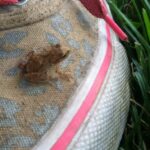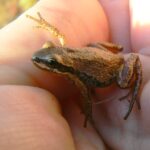By Casey Smith, Naturalist

Just hopping by to introduce myself. You may have heard of me… well, at least HEARD me. This time of year, in the transition from winter to spring, amphibians like me gather in wetlands and vernal pools to find our soul mates. Can you think of what sound frogs make? If you said “ribbit” you’re half correct. There’s no frog in Ohio that says “ribbit”. It’s believed that early Hollywood producers used the sound of the Pacific tree Frog for night scenes, and their ribbit sound became associated with all frogs. Each frog species has a distinct call that you can use to identify us. I’m a spring peeper. I’m a small tree frog with a brown X on my back. My call is a high pitched “peep” sound repeated about 20 times a minute. Over the breeding season, female spring peepers lay 750-1200 eggs that hatch anywhere from 2 days to two weeks later. Spring peeper tadpoles will transform into frogs over the next 6-12 weeks.

I’d also like to introduce you to another frog you hear calling this time of year, my friend the western chorus frog. Like me, these frogs are small with a dark brown mask across their eyes. You can imitate their sound by rubbing your thumb down the teeth of a comb. Female western chorus frogs lay 500-1500 eggs during the breeding season. Their tadpoles take 5-12 weeks to change into frogs.
We both prefer to lay our eggs in wetlands and vernal pools because these bodies of water lack fish. Even without fish, there are plenty of other predators that feed on frog eggs and tadpoles, and even adult frogs. That’s the reason we lay 1000 eggs a season. That gives us a better chance of at least a few of us surviving to carry on the next generation. Later in spring and summer you’ll hear more of my amphibian friends, like the American toad, the gray treefrog, the green frog, and the bullfrog. And while that weather predicting groundhog often gets it wrong (seriously, his accuracy is only 39%), listening to the type of frog singing is a much better way to mark off the seasons. Each species takes its turn serenading the sunset, looking for a mate.






